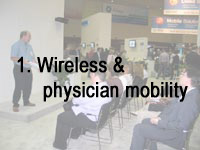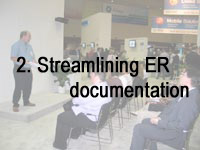 Hi! I’m the Best-Practice Fairy. My mission is to dig up articles that cover the implementation aspect of speech recognition technology within healthcare settings. Here is one.
Hi! I’m the Best-Practice Fairy. My mission is to dig up articles that cover the implementation aspect of speech recognition technology within healthcare settings. Here is one.
In the October issue of Health Imaging & IT, Journalist Beth Walsh interviews a number of key North American healthcare executives about their experience deploying speech recognition technology. This article really caught my attention as I believe it offers what healthcare professionals really want: a way to learn from each other. Whether it is in a Radiology or ER setting, implementation tips converge: all respondents insist on the importance of a gradual rollout, as well as on a the importance of interfaces to make sure that the technology fits the way physicians work, and not the other way round. This is particularly key when it comes to using speech recognition in the ER, where mobility is the name of the game. Here are a few extracts:
Implement Voice for the Right Reasons
Implement voice for the right reasons, says Selle. “Our goal was not to make money off the system, but to provide a service to the facility and improve our marketability to the community and referring physicians.”
Emergency department notes must be relatively up-to-date, says Rosenthal. “In other areas, you can wait to see notes.” And since two-thirds of the hospital’s ED volume occurs outside of the standard 9-to-5 day shift, “voice recognition offers a good opportunity to do notes whenever we need them,” he says.
Project Set-up
Both Selle and Rosenthal say that the implementation of voice recognition warrants a thorough evaluation of workflow and an infrastructure geared to the technology. “Interfaces needed to be set up between facilities’ management systems to generate orders,” says Selle. That way, you’ll have the same patients on the voice worklist as are on the PACS or other systems clinicians are reading off of. He recommends setting up destinations for reports once they are dictated and physicians have signed off. “Set up network printers in the ED that will print reports directly to clinicians,” Selle says. “There’s also the interface on the backend to send the reports electronically into the facility’s systems so that they’re accessible and combined with patient information.”
Rosenthal says it’s common for hospitals to underestimate the setup required for voice recognition. “You need a vision of where [the technology] will go,” he says. For example, if your bandwidth is too slow, people won’t want to use the system. Plus, you won’t have the capability to eventually expand to nurses using voice recognition and performing electronic documentation, for example.
Overcoming Resistance
Rosenthal says that new technology will only be successful if it adapts to the way people already function. “You can buy the nicest solutions, but if people have to go out of their way to work in a different manner, they won’t use it.” That principle has played out, he says, as vendors are offering more ways to use voice recognition and bringing it into various applications. “The technology is fitting more into the way people work.” High failure rates in the early days of voice recognition were due to systems that asked busy clinicians to do things they wouldn’t normally do, he says.
Aurora Health Care, a 14-hospital, not-for-profit system covering eastern Wisconsin (…) purposely implemented voice recognition on a gradual basis. One reason for that was physician resistance, Hartig says. “I think resistance is normal. Most people resist change. We wanted the end-users to embrace it. We didn’t want to force it on them.” The organization still had its old system from Dictaphone so the physicians could opt to use that system or the new PowerScribe solution. The doctors who did use PowerScribe were able to reduce their report turn-around times very quickly, Hartig reports.
Gradual Implementation
Rosenthal says it’s very important to implement voice in phases. “Don’t deploy [it] on a large basis until you’ve run a good pilot and it’s functioning well,” he advises. His facility has been using voice for follow-up notes and is in the process of progressing to more complex documentation. Rosenthal has noticed that people are more willing to share their experience and knowledge about technology than they were in the early days of voice. “What we’ve done in the ED is now being deployed elsewhere in the hospital. Why reinvent the wheel each time? If somebody else can benefit, I think that’s good.”
> Read full article
 Looks like speech recognition has left Star Trek to enter the mainstream. Hot like the southern breeze itself this year in Orlando, SR attracted crowds like never before. While physician skepticism seems to have vanished like a David Copperfield act, an increasing number of healthcare facilities came by the Crescendo and Philips booths to discuss technology advancements and upcoming implementation projects. These projects are bigger than ever, with a number of large healthcare groups looking to equip hundreds of physicians from multiple specialties with back-end SR, front-end SR, or both, by the end of the year. In this regard, attendee interest shifted from “does the technology work?” towards “how are other hospitals and clinics actually implementing it?”
Looks like speech recognition has left Star Trek to enter the mainstream. Hot like the southern breeze itself this year in Orlando, SR attracted crowds like never before. While physician skepticism seems to have vanished like a David Copperfield act, an increasing number of healthcare facilities came by the Crescendo and Philips booths to discuss technology advancements and upcoming implementation projects. These projects are bigger than ever, with a number of large healthcare groups looking to equip hundreds of physicians from multiple specialties with back-end SR, front-end SR, or both, by the end of the year. In this regard, attendee interest shifted from “does the technology work?” towards “how are other hospitals and clinics actually implementing it?”








 As previously discussed on this blog, the ER Department of the Sir Mortimer B. Davis – Jewish General Hospital in Montreal, QC, introduced a wireless document creation and management system that uses PDA devices and speech recognition to accelerate the delivery of critical information at the point of care. Just released, the case study provides details on Dr. Rsoenthal’s vision behind the project, key project milestones and achievements.
As previously discussed on this blog, the ER Department of the Sir Mortimer B. Davis – Jewish General Hospital in Montreal, QC, introduced a wireless document creation and management system that uses PDA devices and speech recognition to accelerate the delivery of critical information at the point of care. Just released, the case study provides details on Dr. Rsoenthal’s vision behind the project, key project milestones and achievements. Hi! I’m the Best-Practice Fairy. My mission is to dig up articles that cover the implementation aspect of speech recognition technology within healthcare settings. Here is one.
Hi! I’m the Best-Practice Fairy. My mission is to dig up articles that cover the implementation aspect of speech recognition technology within healthcare settings. Here is one.
Recent Comments